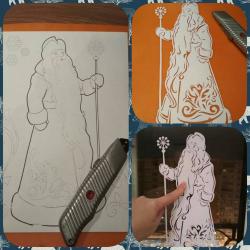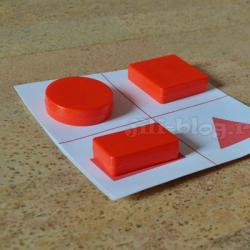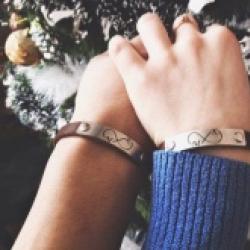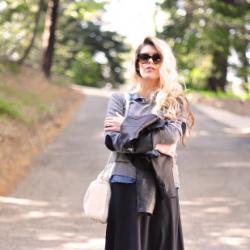Headdress of married women: Magpie. Headdress of a married woman
Women's hats are the most important and obligatory part of everyday and festive Russian clothing. A headdress could tell a lot about its owner, i.e. it was a “talking” part of the national costume. Let's try to understand the rules of wearing and types of women's hats.
By the headdress it was possible to determine which province the woman came from, what her social status was, her approximate income, but most importantly, whether she was married or a girl of marriageable age.

The division in hairstyles between young unmarried girls and married women was very clear. A girl always wore one braid and always (in the warm season) exposed the top of her head and the braid itself, while a married woman had to braid two braids and at the same time hide her hair from prying eyes. In those days, there was even such a wedding ritual - a girl’s braid was unraveled and then remade into a special woman’s hairstyle.

The girls' braids were decorated with ribbons, but the main beauty of a woman's hairstyle was long, shiny, healthy hair, by which grooms could judge the health of a potential bride. A married woman's two braids symbolized a couple - husband and wife. A married woman's head should always be covered with a scarf or headdress, not allowing even a strand to fall out from under it.
It was considered a great disgrace to make a fool of yourself - i.e. remain bareheaded. Even if the cover was torn off accidentally, for example during a quarrel, the woman had the right to go to court to punish the offender.
Braids were unraveled only during magical rites, during childbirth or at the funeral of parents.
Vintage hats

A scarf on the head of a married woman, especially after the Baptism of Rus', was considered a symbol of female purity and nobility, obedience and humility before her husband and God.

It was also believed that a married woman demonstrated her dependence on her husband with a scarf, and a stranger could not touch or disturb her. The scarf gave a woman a feeling of protection, security, belonging to her husband, and also added femininity, modesty and chastity.
The main women's headdress for girls had a single base - a wreath (bandage, headband)

Koruna (koruna, hoop, chiltse, pochelok, duckweed, crown) - Slavic maiden headdress, from the same series as the wreath

Kichka - a headdress on a solid base, was distinguished by its variety and imagination of the solution. Only by shape they distinguish tussocks as horned, hoof-shaped, spade-shaped, bowler-shaped, in the form of a hoop, oval, semi-oval, etc.

Borushka (morkhatka, morshen, collection) is a headdress for married women, belonging to the type of kokoshnik-collections. Soft hat embroidered with gold and silver threads

Soroka - an ancient Russian headdress for married women

Nametka (namitka) is an ancient traditional women's headdress of the Eastern Slavs. It is a strip of very thin white kuzhel fabric, tied in a special way around the head

Povoynik (povoy, povoyets from povovat; Ukrainian ochipok; Belarusian kaptur) - an ancient headdress of married women, which was a linen cap, sometimes with a hard headband, decorated with galloon, completely covering the hair, braided in two braids

Ubrus - part of a married woman's headdress - a towel, a rectangular cloth 2 meters long and 40-50 cm wide, richly decorated with embroidery

It was placed around the head on top of a podubrnik (a soft cap that covered the hair) and tied or pinned with pins.
Kokoshnik is the most famous women's headdress. True, in the form in which we are accustomed to seeing it (in the Snow Maiden, for example, with an outward braid) it is a modern invention. Kokoshnik in its original form - a cap on the head

One-horned kokoshnik is a rich headdress for a married woman; the hair at the back was hidden under a scarf. Embroidery, the number of jewelry and size showed the social status of the woman

The base of the kokoshnik was made of glued or quilted canvas or cardboard. On top, the base was covered with fabric and decorated with embroidery, foil, beads, precious stones, flowers, and pearls. The back of the head of the kokoshnik was often covered with embroidery.

The kokoshnik consists of a headpiece (a semicircle on the front side) and a hairpiece or bottom (a cap at the back). The kokoshnik was tied at the back with ribbons. Along the edges of the kokoshnik there could be pearl threads - ryasny, and in front there was a net of pearls - underneath.
Two-horned kokoshnik

One-horned kokoshniks (far right - with cones - the personification of fertility)

Kokoshnik is a festive headdress and it comes in different types: one-horned, two-horned and saddle-shaped kokoshnik, as well as in the form of a hat with a flat bottom and a high brim


Vintage women's holiday outfits
Women's headdress. Magpie.
Magpie/ kitty, horns/ - a headdress for married women, consisting of several parts not sewn together, which were put on the head independently. The main items that together formed this headdress were the kichka, the magpie itself, the back of the head, the forehead, and the scarf. Additional - various decorations made of beads, feathers, ribbons, artificial flowers.
The kitchka was a soft canvas cap, on the front of which was fixed a solid elevation made of bast, wooden planks, birch bark, canvas glued or quilted several times, canvas rollers stuffed with straw, tow. At the back, the kitty was pulled tight, tightly fitting the head.The magpie, also called the crown, the binding, is the upper part of the headdress, a cover worn over the kichka. It was usually made of calico, silk, velvet on a canvas or chintz lining. Magpies were usually sewn from two to three pieces of fabric. Its front part was called brow, ochele, chelishko; the side parts are the wings, the back part is the tail. They were connected in such a way that the headdress took the form of a cap with a rectangular, oval top, or a top carved in the shape of horns. The wings, sewn with a headband and partly with a tail, had ties with which the magpie was attached to the head over the kitty. If the magpie's tail was short, then it was almost completely sewn together with the wings; if it was long, then a significant part of it went down to the shoulders. Along with magpies in the form of caps, magpies that were not completely sewn together were also common: only the headbands with the tail and the wings with the headband were connected. Such magpies, when spread out, resembled a bird with a long tail and triangular wings spread out on the sides.

Rice. 3. Development of the image and symbolism of the kichka, from left to right: 1 - Veles in a horned and circle-shaped headdress with the duck star Makosha in the center; 2 - Egyptian god in a horned headdress and with a circle; 3, 4 - on the Egyptian fresco the horns turned into two feathers of Maat (Makoshi) with the sun inside; 5 - Russian kichka, Tambov province (19th century); 6 - fragment of the pattern; 7 - Scythian-Koban figurine from Dagestan (6th century BC); 8 - horned kichka - wedding headdress of a Nekrasovka Cossack woman (early 19th century); 9 - horned Makosh, Russian embroidery; 10 - Russian kitty
The Russian national headdress - kichka - also drew its symbolism from the star Slavic religious cult of the duck-Makoshi (constellation Pleiades), located on the head (neck) of Veles (constellation Taurus). The back of the head, also called the back of the head, the back of the head, the block, was a rectangular piece fabric, glued or sewn onto a solid base made of cardboard, birch bark, or quilted canvas. It was placed on the back of the head, covering the hair at the back of the head and part of the neck, and tied with ribbons around the pussy under the magpie. The drawings clearly show the development of the image of the Slavic god Veles, holding a Makosh duck with a nest on his head. In fragments 3 and 4, the horns turn into feathers (ostrich), which symbolize the Egyptian Maat (Russian Makosh). On the kitty (5) there is a pattern, which is presented on an enlarged scale in fragment 6. It is completely similar to the Egyptian two feathers and the sun between them. The oldest sculptural image of Mokosh is dated to the 42nd millennium BC. and found in Rus', in the village of Kostenki, Voronezh region. Therefore, we have the right to attribute both the origin and development of the cult of Mokosh in Rus' to the Slavs, and consider the Egyptian use of this Slavic cult of Mokosh-Maat as its continuation, brought to the Nile Valley by proto-Russian settlers. The Proto-Russians also brought to Egypt the cult of the Slavic god Veles-Baal, whose horns turned into two feathers in Egypt.
It was precisely this content, corresponding to Slavic religious mythology, that the kitchka carried. This Russian headdress imitated the horns of a cow, which symbolized the fertility of its owner. Young married Russian women wore a horned kitty, exchanging it in old age for a hornless one. Slavic married women for a long time (and to this day!) retained the method of tying a scarf, when its corner ends stuck out on the forehead in the form of small horns. They also imitated the horns of a cow and symbolized a productive period in a woman's life.

A merchant's family in the 17th century. 1896. A. Ryabushkin




Soroka (kichka, horns) is one of the most ancient Russian headdresses for a married woman. According to archaeological excavations, the magpie was worn in the 12th century and even then it was widespread throughout Russia. Usually the magpie consisted of the following parts: a quilt, a magpie, a back of the head, a forehead, and a scarf. Kichka is a round canvas cap; on its front, frontal side, a hard part made of bast (linden or elm bark), wooden planks, birch bark or other materials was attached. The upper part, rising above the cap, was called kichka (or “horns”, “sderiha”). They came in a variety of shapes: spade-shaped, semicircular and horn-shaped. Horns have long been a symbol of fertility; perhaps they carry the same meaning in the magpie.
The magpie itself was a long woven fabric that was attached to the pussy and went down to the back and shoulders. The back of the head is a fabric with a hard base, laid at the back to cover the hair at the back of the head. Browband - an embroidered strip that covered the forehead, tips of the ears and temples. A scarf was also tied over the magpie.


Second half of the 19th century. Spassky district, Tambov province, Russia.




The magpie is found in most provinces of Russia as a widespread women's headdress, which has very ancient roots. The Kargopol magpie can be immediately distinguished from any other by the peculiar shape of its headband, hanging over the forehead with a sharp protrusion. This protrusion is created by a pointed bottom. As a rule, most of the known species of magpies are soft, so under them they additionally wore a headdress of a rigid design, allowing them to maintain the shape of the headband. Under the Kargopol magpie, a kind of cap is put on with a hard “hoof” above the forehead, called “sderikha”. Sderiha plays the role of a warrior, collecting and pulling her hair, and the hoof serves as the basis for an elegant beaded headband



The “magpie” wedding headdress consisted of three parts: a kichka with small sharp horns, a back of the head and the “magpie” itself, which was heel-shaped. The magpie is an ancient headdress worn by Russian women. The basis of the wedding headdress of a Voronezh peasant woman is a kichka - a solid forehead part in the form of a horseshoe with large horns sticking up, lined with red. A piece of canvas is attached to it, the edges of which are gathered on a thin cord - a “hold”. The kichka is placed on the head at forehead level and the woman’s hair is carefully covered with canvas, then the fabric is secured to the head with a cord. The back of the head is covered with a backplate - a rectangular strip of velvet embroidered with gold threads, fixed on cardboard for rigidity, to the top and sides of which strips of silk fabric with ties at the edges are sewn. I cross them on the forehead and tie them around the horns several times, thus tightly fastening the kitty to the back of the head. And finally, on top of the horns they put a small magpie sparkling in gold, which crowns the entire structure. The main motifs of the gold embroidery ornament on the back of the head and along the top of the magpie are “trees”, similar to similar images on the sleeves of a wedding shirt.


The "magpie" pattern has 3 main parts - the headband, the back of the head and a special patch made from the main fabric, which lengthens the back of the head. The design has a rigid frame - a sewn-in cardboard strip 20 cm high. Ties, 5 cm wide, made of cotton fabric, are attached to the headband. The headdress is set on lining fabric. The sample is made of velvet fabric. The necklace is richly decorated with gold embroidery, colored rhinestones and sewn brocade braid. A braid of multi-colored beads is sewn on, and fringe is sewn along the edges of the headband. The back of the head is decorated with embroidery using the “gold embroidery” technique, the ornamentation is made in the form of plant motifs. Three lush tassels of red and green colors are sewn to the bottom of the sewn part of the back of the head. The decorative connection between the headband and the back of the head is two strips of gold braid.
Sometimes they write that “magpie” is part of the “kichka” headdress, and sometimes vice versa: “ Usually the magpie consisted of the following parts: quilt, magpie, back of the head, forehead, scarf.”.

koruna
The kika was worn over the warrior, and it consisted of a hoop, open at the back, covered with fabric on top. The hoop had the shape of a crescent or horseshoe. The height of the horns for kiki could reach 30 cm; they were made of wood or tightly rolled canvas. The back part made of expensive fabric or fur was called slap on the head, they decorated it especially elegantly, because it was he who replaced the braid that the woman had lost. Rich embroidery or a wide decorative pendant with long chains of plaques was placed here. A cover-cover called a blanket was attached to the top of the kick. magpie, he would later give the name to this composite headdress. In such vestments, a woman should walk with her head held high, with a beautiful and soft gait, which gave rise to the expression “to boast,” i.e. rise above other people.
A type of kiki for persons of the princely and royal families was koruna. It was distinguished by its shape - a richly decorated crown, under which a headdress was worn. Duckweeds, a pearl hem on the forehead, and kolta were added to the attire, inside of which they placed pieces of fabric soaked in “fragrances,” i.e. perfume.
We still have a hat on our head. Or a hat, or a beret, or a few other options, very few.
Even more often, in cities, even in winter - nothing. We walk around with our heads uncovered, bare-haired.But the headdress has always been extremely important. It's not even a matter of health, although in a cold climate you can't run around uncovered for long. It's also a matter of status. For men, social status also manifested itself (“not like Senka’s hat”), and for women, family status was also evident.
“A woman is not happy about howling, she would be happy about peace”
In villages, before marriage, girls braided their hair in one braid (this applied to the central regions of Russia; Ukrainian girls could braid two braids). As in the song: “The braid is long, three arshins long, the scarlet ribbon is two and a half long.” After the crown, most often two braids and a headdress were required. It was simply unacceptable to walk around bare-haired. And only mermaids and witches could afford to have loose hair...
Kika, kichka, kokoshnik, magpie, cap, volosnik, ubrus, fly– how to understand the headdresses of married women?
The oldest Slavic women's headdress - bastings, or namitki. It was distributed everywhere to the western borders. The methods of tying this scarf, however, were different everywhere. But often, and not only among the East Slavic peoples, “hornedness” occurs. Many researchers attribute this manner to the most ancient amulets or consider it a symbol of fertility. So two-horned and one-horned headdresses (or even “five horns”) have been the most common for centuries.
And the gypsy girl is dancing,
He's beating the drums,
The blue fly is waving,
He pours out and sings.
(A. Pushkin)
Fly(towel, or basting) was worn mainly in the center and west of Russia. From the name “towel” it is clear that this is a cloth with woven ends. A fly is a strip of canvas (cut to width - hence the name), a small scarf, often embroidered.
And say: “After all, for the capture
I need two pants, king,
gold embroidered tent,
yes, a dining set”...
(P. P. Ershov)
Flies were an integral part of a woman's wardrobe: “Our girls have colorful flies for housewarming parties and funerals” (N. Klyuev). Subsequently, the word “fly,” as we know, passed into the dictionary of men’s wardrobe.
Another ancient type of headwear is a hoop. Hoop (kibalka, horns)– made of tree bark (walnut, oak) in the form of a circle, covered with fabric on top and decorated with beads. The hoop was born from a sling. The dressing (bandage, ribbon, bandage, scrofula, forehead, wreath) - from a strip of fabric, brocade, braid with ties at the ends, was made with the goal of “not exposing the hair.”
Subsequently, the women's headdress became more complex. Povoinik, povoy – also known as shlyk, cap, volosnik, ochipok- This is only the basis for the headdresses of married women. A small quilted cap with a scarf (towel, headband, veil, scarf, fly) wrapped around it. “Sin is covered (with a scarf, kick, howl)” - there is a saying from Dahl.
Kika (or kichka)- an everyday, but elegant high headdress, consisted of a crown in the form of a hoop, expanding at the top. Below, pearls, beads, and fringe were hung from the front of the kicks. Near the ears there are cassocks or cassocks: long strings of pearls with gold figures. The back could be velvet or fur. On top of the kiki there was a magpie - a cover made of embroidered fabric, with precious stones or pearls. Widows wore white magpies. It is believed that the magpie was the predecessor of the kokoshnik. By the way, both words contain images of birds. And images of birds are also often found in embroidery motifs. The magpie on the kitsch was worn only in the central and southern regions of the Russian Empire.
A. Pushkin expressed himself very figuratively about kitschka (and shushuna):
In a venerable kitschka, in a shushun,
Moscow is a lovely old lady.
Diverse and lively
It captivates with its diversity.
(A. Pushkin. “Vsevolozhsky”)
The kitties were different in shape: horned (especially during the period of “early marriage”), hoof-shaped, bowler-shaped, shovel-shaped (after the birth of children). They are especially widespread in the southern regions of Russia. “Human kichka” was first mentioned in documents of the 14th century, but I quote from Wikipedia something very unexpected: “In the Voronezh region, kichka was preserved as a wedding attire until the 1950s.”
Another interesting fact. Many people remember the old expression that we inherited from the Volga robbers - “Saryn on the kichka!” Here saryn is a crowd, and kichka is an elevated part on the bow of the ship (that is, make way and give up!). Perhaps this is no coincidence - after all, it means elevation. It’s interesting that the word “ kokoshnik"is also in the dictionaries of architectural terms - this is an ancient decorative element in the crowning parts of buildings (including churches).

V. Vasnetsov. Portrait of V. S. Mamontova (in a one-horned kokoshnik)
The kokoshnik has become a symbol of the Russian national headdress. The incredible complexity of making a shield-comb-fan around the head. Both girls and married women wore kokoshniks.

Konstantin Makovsky. “The Hawthorn at the Window” (as we see, we are talking about a girl)
This opinion is sometimes disputed; as an argument, girlish conspiracies about marriage are cited: “Protection of the Most Holy Theotokos, cover my wild head with a pearl kokoshnik, a golden cuff!” You don’t need to think that girls dreamed of slaps on the head from their future husband, even “golden” ones. The back of the head (the back of the head) is a special decoration for the kokoshnik or for the magpie.

Ivan Petrovich Argunov, Portrait of an unknown woman in Russian costume, 1784.
Most likely, the rules for wearing kokoshniks were different in different areas. One way or another, the kokoshnik remained a traditional women's headdress, worn in most areas, in villages and towns, and even at court. Under Peter the Great, it was, however, banned, but later it returned as a headdress for the nobility - this is how they paid tribute to tradition.

Empress Alexandra Feodorovna in a kokoshnik. Kruger
Kokoshnik was an expensive pleasure. It was decorated on top (with braid, beads, pearls, precious stones) and embroidered with gold threads.
Kokoshniks also came in several types and shapes: one-horned, two-horned, cone-shaped, cylindrical, saddle-shaped. And over the kokoshniks they often wore a scarf called ubrus. It was pinned under the chin or loosely released onto the shoulders.

M. Nesterov, Girl in a kokoshnik. 1885
Shawls in the future they completely replace other women's headdresses. There were different scarves made of canvas and chintz. And they tied it everywhere in different ways: on the top of the head, in the back, in the front, under the chin. Shawls also appeared. Scarves are still in high esteem, however, today's fashionistas are showing greater interest in scarves.
In cities, women could wear hats in the cold season. According to the famous traveler Olearius: “On the heads (of rich women) are wide and spacious hats made of gold brocade, satin, damask, with gold braids, sometimes embroidered with gold and pearls and trimmed with beaver fur... Adult girls have large fox hats on their heads.” (Adam Olearius. “Description of the journey of the Holstein embassy to Muscovy and Persia”). The styles of these hats were different in different areas.
Scarves and hats are what have been preserved in our wardrobe from the past to this day. We can say that women's hats have changed. But with regard to men's hats, one cannot say so categorically...
In the old days in Rus', girls and women loved luxurious outfits no less than today. Particular attention was paid to headdresses. They were made from the best fabrics, decorated with silver and gold embroidery, sequins, beads and pearls. Our review contains 18 photographs of headdresses that women wore a couple of hundred years ago.


Women's headdress occupied a special place in Russian folk costume. Looking at it, one could determine what area its owner was from, how old she was, her social and marital status.


Traditionally, the shape of the Russian folk headdress was combined with the hairstyle. Girls braided their hair, and their headdress most often looked like a bandage or a hoop with an open crown.


Married peasant women braided two braids and rolled them into a bun at the front. The headdress was supposed to completely hide the stripes of a married woman. Traditional women's headdresses in Russian folk costume consisted, as a rule, of several parts.


Kichka is a part of a kichka-shaped headdress on a solid base. Kichkas were distinguished by a variety of styles. They were horned, hoof-shaped, spade-shaped, bowler-shaped, in the form of a hoop, oval, semi-oval - the imagination of the solutions was limitless.


In the Ryazan, Tula, Kaluga, and Oryol provinces, as a rule, they wore horned kichkas. In Vologda and Arkhangelsk - hoof-shaped kitties. The latter researchers associate it with the Finno-Ugric ancestors (X - XIII centuries), who had similar headdresses.


Soroka was the name of the top decorated headdress. It was made of fabric and stretched over a kitty.
Another element of the kitty-shaped headdress is the back of the head. It was made of fabric (usually brocade) or beaded. The back of the head was tied at the back of the magpie to hide the woman's hair at the back of the pussycat.


The kokoshnik, unlike the magpie, was only a festive headdress, including a wedding one. In the northern provinces it was often decorated with pearls. If the kichka was worn by peasant women, then merchant women and bourgeois women wore a kokoshnik on their heads.

Kokoshniks were made in monasteries or by craftswomen in large villages and sold at fairs. By the end of the 19th century, the kokoshnik almost completely replaced the kichka, and then the kokoshnik left the arena, giving way to scarves. At first, scarves were tied over the headdress, and later as a separate headdress, pinned or tied under the chin.

You can imagine what Russian women looked like by looking at the gallery from.
Hats and their parts are usually listed as part of the dowry. In 1668, in the city of Shuya, three volosniks were described: “A volosnik with edging, edging with nizan grains (pearls - M.R.) in half with stones and with emeralds and with yakhonta and with grains; gold hairline with trim, trim sewn with bit gold trimmed; golden hairline, stitching embroidered with drawn gold from grain; double chain lining.” In the same city in 1684, apparently, the family of the feudal lord was given three dowries kokoshnik: “kokoshnik nissan on worm-shaped satin; kokoshnik embroidered with gold on taffeta; taffeta kokoshnik with silver braid.” In 1646, among the property of the townsman - Shuyanin, there were, by the way, “8 forty embroidered with gold... the kitch is expensive green, the headband is embroidered with gold.” In 1690, a Moscow will mentioned a “nizana kokoshnik with a yakhonta with an emerald.” In 1694, in the city of Murom, among the dowry of a girl from the Suvorov family - “a lowered kokoshnik, 5 sewn kokoshniks with braid, 5 satin and damask lingonniks, lowered trim, chain trim.” In 1695, A.M. Kvashnin gave his daughter 11 kokoshniks - 3 ceremonial ones and 8 simpler ones. The daughter of A. Tverkova from the city of Kashin also received the kokoshnik as a dowry. In 1696, guest I.F. Nesterov gave his daughter a “pearl kokoshnik with a stone.” The differences here are more likely social than territorial: magpie and kika are among the townspeople, kokoshnik among the feudal lords and the upper class of merchants. If we remember that in the middle of the 17th century. Meyerberg depicted a Moscow peasant woman in a kitsch-shaped (widening upward) headdress, it can be assumed that in the central Russian lands - the former Moscow and Vladimir principalities - at least in the 17th century. was women's kitty headdress. Kokoshniks They were also part of the toilet of noble and rich women everywhere. We said earlier that in the northern Russian lands some kind of headdress on a rigid basis existed until the 13th century. But Kika and the parts of the headdress that accompanied it, which were mentioned above, were probably more widespread and therefore even in the 16th century. entered into such an all-Russian guide to the organization of family life, which was Domostroy. So, a traditional, very complex headdress, which was not removed even at home, was characteristic of the entire period we are considering and was retained by some social strata also much later, for almost another two centuries. When going out into the street, a woman put on a scarf or (for the wealthy) a cap or hat over this headdress. Sources know, in addition to the general name cap and hat, also special terms that denoted women's street hats of various styles: kaptur, triukh, stolbunets and even cap. Women hats They were round, with small brims, richly decorated with cords of pearl and gold threads, and sometimes with precious stones. Hats They were made of fur, mostly with a fabric top. The stolbunets hat was tall and resembled a man's gorlat hat, but it tapered towards the top and had an additional fur trim at the back of the head. The Kaptur was round, with blades that covered the back of the head and cheeks, the triukha resembled modern earflaps and had a top made of expensive fabrics. Sometimes a scarf - a veil - was tied over a fur hat, so that its corner hung down the back.
Men's hats also underwent in the XIII-XVII centuries. significant changes. The hairstyle itself has also changed. In the 13th century Loose hair cut just above the shoulders was in fashion. In the XIV-XV centuries. in the north of Rus', at least in the Novgorod land, men wore long hair, braiding it in braids. B XV-XVII centuries. hair was cut “in a circle”, “in a bracket” or cut very short. The latter, apparently, was associated with wearing at home a small round cap that covered only the top of the head, like an oriental skullcap - tafya or skufya. The habit of wearing such a hat already dates back to the 16th century. was so strong that Ivan the Terrible, for example, refused to take off his taffe even in church, despite the demands of Metropolitan Philip himself. Tafya or skufya could be simple dark (for monks) or richly embroidered with silks and pearls. Perhaps the most common form of the cap itself was cap or kalpak- tall, tapering at the top (sometimes so that the top curled and sagged). At the bottom of the cap there were narrow flaps with one or two holes, to which decorations were attached - buttons, cufflinks, fur trim. Caps were extremely widespread. They were knitted and sewn from different materials (from linen and paper to expensive woolen fabrics) - bedroom, indoor, street and front. In the will of the early 16th century. An interesting story is revealed about how the Russian prince Ivan took various family jewels from his mother, the Volotsk princess, “for temporary use” - including earrings from his sister’s dowry - and sewed them onto his cap, but never gave them back. This cap must have been a very elegant headdress for a dandy. A century later, among the property of Boris Godunov, a “fat cap” was mentioned; it has 8 cuffs and 5 buttons in the hole.” Kolpak or, as it was called then, hood was widespread in Rus' in ancient times. A type of cap was in the 17th century. nauruz (the word itself is of Iranian origin), which, unlike the cap, had small brims and was also decorated with buttons and tassels. The margins of the nauruz were sometimes curved upward, forming sharp corners, which miniaturists of the 16th century liked to depict. G.G. Gromov believes that the Tatar cap also had a pointed top, while the Russian headdress was rounded at the top.
Men's hats had round brims (“brim”) and were sometimes felted, like later peasant hats. Such a hat with a rounded crown and small, curved brim, which apparently belonged to an ordinary citizen, was found in the city of Oreshka in the 14th century layer. Among the wealthy segments of the population in the 17th century. Murmolki were common - tall hats with a flat crown, tapering upward, like a truncated cone, and with fur flaps in the form of blades, fastened to the crown with two buttons. Murmolki were sewn from silk, velvet, brocade and additionally decorated with metal agraphs.
Warm men's hats were fur hats. Sources call three or malachai — hat with earflaps, the same as for women. The most ceremonial was the throated hat, which was made from the neck of the fur of rare animals. It was tall, widening at the top, with a flat crown. Along with gorlat hats, worm hats are also mentioned, that is, made from fur taken from the belly of the animal. Just as it was customary to put on one piece of clothing on top of another during formal exits (for example, a zipun - caftan - a single-row jacket or a fur coat), they also put on several hats: tafya, a cap on it, and a gorlat hat on top of it. Clerics of various ranks wore special headdresses (various types of hoods). The prince's hat remained an important regalia of the rulers.






